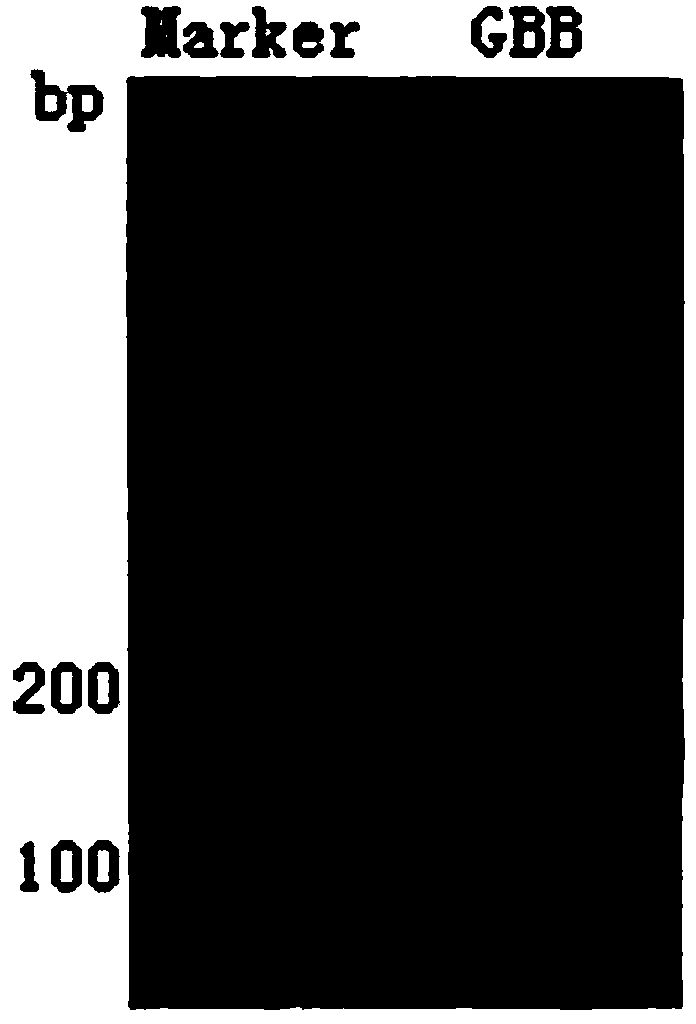Preparation method and applications of antibacterial peptide
An antimicrobial peptide and expression system technology, applied in the field of antimicrobial peptide preparation, can solve the problems of low yield of gene expression, complicated separation and purification process, small molecular weight of antimicrobial peptide, etc., achieve high purity of antimicrobial peptide, improve protein purity, and easy operation Effect
- Summary
- Abstract
- Description
- Claims
- Application Information
AI Technical Summary
Problems solved by technology
Method used
Image
Examples
Example Embodiment
[0050] Example 1 Preparation of antimicrobial peptide GBB using a non-fusion tag expression system
[0051] 1. Construction of pET28a-GBB vector
[0052] According to the literature Lee EK et al. Peptides. 2011, 32(6): 1123-30. The amino acid sequence of the antimicrobial peptide GBB disclosed: GRFKRFRKKFKKLFKKLS* (SEQ ID NO. 1), the gene sequence P1 of the antimicrobial peptide GBB was translated and designed using The software Genetyx designed the complementary sequence P2 of P1, using the annealed products of P1 and P2 as templates, and P3 and P4 as primers, by PCR (PCR conditions: 98℃ 1min; 98℃ 15s, 63℃ 15s, 72℃ 15s, 35 cycles; 72℃5min) to obtain GBB gene, using Phusion DNA polymerase (NEB Biolabs), P1, P2, P3 and P4 sequence are as follows:
[0053] P1: 5'GGACGATTCAAACGGTTCCGGAAAAAATTCAAGAAACTATTCAAGAAATTGTCATG A3'SEQ ID NO.2;
[0054] P2: 5’TCATGACAATTTCTTGAATAGTTTCTTGAATTTTTTCCGGAACCGTTTGAATCGTCC3’SEQ ID NO.5;
[0055] P3: 5’GAAGGAGATATACCATG GGACGATTCAAACGGTTCCG 3’SEQ ID NO.6...
Example Embodiment
[0067] Example 2 Preparation of antibacterial peptide GBB using fusion tag expression system
[0068] 1. Construction of pET28a-proteinG-GBB vector
[0069] According to the literature Lee EK et al. Peptides. 2011, 32(6):1123-30. The amino acid sequence of the antimicrobial peptide GBB disclosed: GRFKRFRKKFKKLFKKLS*, the gene sequence P1 of the antimicrobial peptide GBB was translated and designed:
[0070] P1: 5'GGACGATTCAAACGGTTCCGGAAAAAATTCAAGAAACTATTCAAGAAATTGTCATG A3'SEQ ID NO.2.
[0071] 1) Design primers P5 and P6 using plasmid pCeMM NTAP (GS) (GenBank accession number EF467047) as a template, by PCR (PCR conditions: 98℃ 1min; 98℃ 20s, 60℃ 20s, 72℃ 20s, 35 cycles; 72℃ 5min ) Obtain the proteinG gene (fusion tag).
[0072] P5: 5’CAGCCATCATCATCATCATCACATGGGCACCCCCGCAGTCA3’SEQ ID NO.8; P6:
[0073] 5’GCCCTGGAAGTACAGGTTTTCACCAGAACCCTCAGTCACAGTGAATGTCTTCG3’SE Q ID NO.9.
[0074] 2) Design primers P7 and P8, first use the product of step 1) as a template to perform PCR reaction (PCR con...
Example Embodiment
[0095] Example 3 Bacteriostatic test of antibacterial peptide GBB
[0096] Take GBB solutions with concentrations of 5, 10, 20, 30, 40 and 50μM and 3 antibiotics (450mg / L ticarcillin sodium (Tic), 500mg / L carbenicillin (Car), 200mg / L cephalosporin). (Cef)) Right 10 8 / ml Agrobacterium EHA105 was treated for 2h and cultured at 28°C for 48h, the colonies were counted. Calculate the inhibition rate ( Picture 9 , Picture 10 ).
[0097] Antibacterial rate (%)=(positive control OD value—test OD value) / (positive control OD value—negative control OD value)×100
[0098] The results showed that the antibacterial peptide GBB had a bacteriostatic rate as high as 98%, which was significantly higher than the contrast group of three antibiotics with higher concentration.
PUM
 Login to View More
Login to View More Abstract
Description
Claims
Application Information
 Login to View More
Login to View More - R&D
- Intellectual Property
- Life Sciences
- Materials
- Tech Scout
- Unparalleled Data Quality
- Higher Quality Content
- 60% Fewer Hallucinations
Browse by: Latest US Patents, China's latest patents, Technical Efficacy Thesaurus, Application Domain, Technology Topic, Popular Technical Reports.
© 2025 PatSnap. All rights reserved.Legal|Privacy policy|Modern Slavery Act Transparency Statement|Sitemap|About US| Contact US: help@patsnap.com



